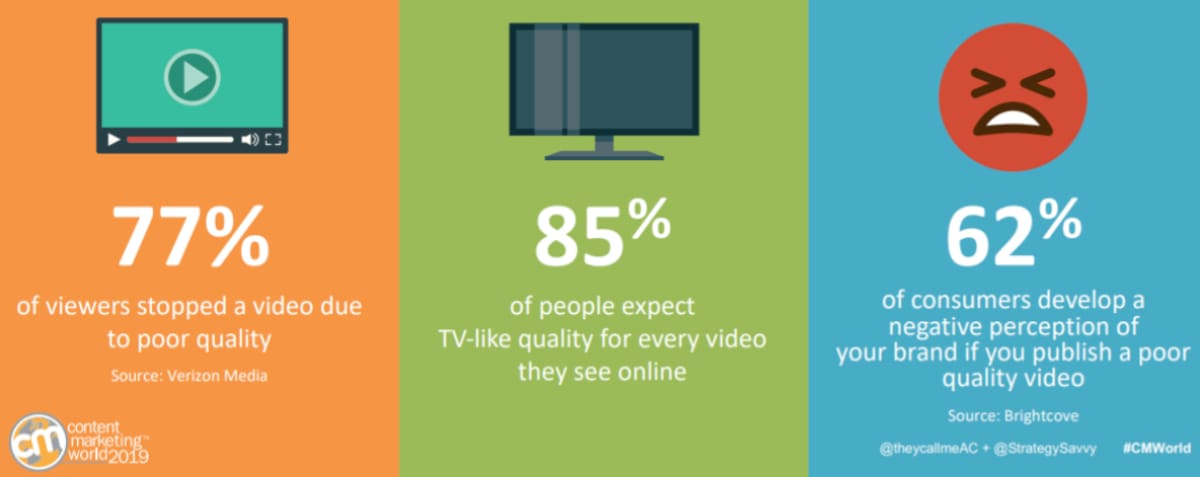Video Marketing For Lead Generation (2024)

Video marketing is a powerful tool for connecting with audiences and driving business growth. It allows complex messages to be conveyed in an engaging, easy-to-understand format using visuals and sound. Video is highly effective for storytelling, brand expression, and lead generation. Its integration into marketing strategies is a profound shift in how businesses engage potential customers.
Studies show video boosts attention, website traffic, and sales conversions. For example, adding videos to landing pages can increase conversions by over 80%. Social media and technology have made video content more accessible and affordable for businesses of all sizes. From product demos to augmented reality experiences, video offers countless ways to attract and nurture leads.
Strategic use of video can guide viewers through the sales funnel, turning prospects into loyal customers. Videos inspire action through education, emotion, and interaction. They increase brand visibility, build trust and credibility - key factors for attracting and retaining customers.
We'll explore using videos to generate leads, including resonating with audiences, creating compelling videos, and measuring success.
Understanding Video Marketing

Video marketing is a planned approach that uses engaging videos as part of marketing efforts. It's not just about making and sharing videos. It's about creating visual stories that connect with your audience, promote your brand, and get people to take action - like making a purchase, visiting your website, or sharing on social media. Video marketing uses moving images and sound to communicate messages better than just text or still pictures. It's a way to show emotions, explain complicated ideas, and tell stories that personally connect with viewers.
Evolution of Video Marketing
Video marketing has changed a lot, driven by new technology and how consumers behave. In the beginning, video marketing was mostly TV commercials for businesses to reach viewers. But then the internet and digital tech revolutionized everything. Platforms like YouTube, started in 2005, allowed marketers to share video content worldwide. Social media has constantly added more video features, understanding videos engage users and keep them on the platform longer. This major change made video marketing more accessible and powerful for businesses of all sizes to connect with customers in innovative ways.
This evolution has been marked by several key trends:
- From Monologue to Dialogue: Initially, video marketing was one-way communication. Today, it encourages interaction, with live videos, comments, and shares making it a two-way street.
- Rise of User-Generated Content: The proliferation of smartphones and affordable cameras has made video production accessible to all, leading to a surge in user-generated content that brands can leverage.
- Personalization and Targeting: Advances in data analytics and AI have enabled more personalized video content, allowing marketers to target specific audiences with tailored messages.
- Immersive Experiences: Technologies like 360-degree videos and virtual reality (VR) have introduced new possibilities for immersive storytelling, making video content not just something to watch, but an experience to engage with.
Key Components of Effective Video Marketing
For video marketing to truly resonate and achieve its objectives, several key components must be considered:
- Storytelling: At the heart of any effective video is storytelling. It’s not just about showcasing a product or service, but about weaving a narrative that engages viewers emotionally.
- Quality Production: While smartphones can produce remarkable video quality, attention to lighting, sound, and editing is crucial for creating professional-looking content that reflects well on your brand.
- Targeted Distribution: Creating great video content is only half the battle; it also needs to reach the right people. This involves utilizing SEO strategies, social media, email marketing, and paid advertising to ensure your videos are seen by your target audience.
- Engagement and Call-to-Action (CTA): Encouraging viewers to engage with your content through likes, comments, and shares can amplify its reach. Including a clear CTA is also essential for guiding viewers to the next step, whether that’s visiting a website, signing up for a webinar, or making a purchase.

The evolution of video marketing reflects broader shifts in technology, consumer behavior, and communication preferences. As we move forward, understanding these dynamics and the core components of video marketing becomes crucial for businesses aiming to leverage this powerful tool for lead generation.
Benefits of Video Marketing for Lead Generation

Video marketing is a standout tool for digital marketing, especially when trying to get new leads. This part of our discussion will show how videos not only grab attention but also convert viewers into customers, providing real benefits for businesses looking to grow their customer base. From increasing brand awareness to directly boosting sales through higher conversion rates, there are many advantages to using videos as part of your marketing plan.
Enhanced Engagement and Brand Awareness
One of the most immediate benefits of video marketing is its ability to engage viewers and create a memorable brand experience. Videos, by their very nature, are more likely to capture attention than text or still images. They offer a multisensory experience that can convey complex information or evoke emotions more effectively. This heightened engagement is crucial for brand awareness, as viewers are more likely to remember and recognize a brand that has delivered content in an engaging, innovative format. Furthermore, videos are highly shareable across social media platforms, increasing the likelihood of viral marketing effects.
Improved SEO and Website Traffic
Videos significantly contribute to search engine optimization (SEO) efforts. Search engines like Google prioritize content that engages users, and videos often lead to longer page visits, signaling to search engines that your site has valuable content. By embedding videos on your website or linking them in your social media posts, you can drive a higher volume of traffic to your site. Additionally, hosting videos on platforms like YouTube and Vimeo and then embedding them on your site can improve your visibility and rankings on search engine results pages (SERPs).
Increased Conversion Rates and ROI
Perhaps the most compelling argument for video marketing in the context of lead generation is its direct impact on conversion rates and return on investment (ROI). Videos can convey the value proposition of a product or service in a clear and engaging manner, helping potential customers understand what you offer and why it matters to them. Including videos on landing pages, product pages, or even in email marketing campaigns can significantly increase the likelihood of a conversion. According to various studies,
including video content in your marketing strategy can lead to an 80% increase in conversion rates on landing pages.
This direct contribution to the bottom line highlights the effectiveness of video marketing not just as a tool for engagement, but as a critical component of a successful lead generation strategy.
Building Trust and Establishing Authority
Video content allows brands to establish credibility and trust with their audience. Through product demonstrations, customer testimonials, and educational content, businesses can showcase their expertise and build confidence in their offerings. This trust is fundamental to converting leads into customers, as people are more inclined to purchase from brands they believe are reliable and authoritative in their field.
Enhanced Customer Insights
Video analytics insights like those found in YouTube Creator Studio, provide deep insights into viewer behavior, preferences, and engagement levels. By analyzing these metrics, businesses can refine their marketing strategies, tailoring content to meet the needs and interests of their target audience more effectively. This data-driven approach to video marketing not only enhances the efficiency of lead generation efforts but also ensures a higher quality of leads, as the content is more likely to resonate with the intended audience.
Types of Videos for Lead Generation

There are many different types of videos for video marketing, and each type is useful for different stages of getting new leads. Short explainer videos make complex products or services easy to understand. Customer testimonial videos help build trust in your brand. The kind of video you choose to make can really impact how well it turns viewers into leads. Let's look at some of the most effective video types for converting viewers into potential customers.
Explainer Videos
Explainer videos are short, engaging clips designed to explain your product, service, or a specific concept in an easy-to-understand and entertaining way. Typically ranging from 60 to 90 seconds, these videos focus on addressing common problems your target audience faces and how your offering can solve them. By breaking down complex ideas into digestible pieces, explainer videos help potential customers understand the value of what you’re offering, making them more likely to convert into leads.
Product Demos
Product demonstrations go a step further by showcasing how your product or service works in real time. They are particularly effective for tangible products or software applications, providing a detailed view of the features and benefits. Product demos can help eliminate any doubts or questions potential leads might have about the product’s functionality, thereby smoothing the path towards a conversion.
Customer Testimonials
There’s no better advocate for your brand than a satisfied customer. Testimonial videos that feature real customers sharing their positive experiences with your product or service can significantly influence potential leads. These videos lend credibility to your offering and can effectively build trust with your audience, showing that your company delivers on its promises.
Webinars and Live Videos
Webinars and live video content offer a dynamic way to engage with your audience, providing valuable information, insights, or demonstrations while allowing for real-time interaction. These formats are particularly effective for B2B companies or businesses that offer complex solutions requiring in-depth explanation. Webinars can be used to educate the audience on industry trends, how-to guides, or detailed product features, fostering a relationship that can be nurtured into leads. Live videos, especially on social media platforms, can also create a sense of immediacy and exclusivity, encouraging viewers to engage directly with your brand.
Educational and How-To Videos
Educational content that provides useful information or teaches your audience how to solve a specific problem can position your brand as a thought leader in your industry. By focusing on the value provided to the viewer, rather than directly selling a product or service, these videos can help build trust and establish your brand as a go-to resource, indirectly generating leads by increasing brand affinity and recognition.
Behind-The-Scenes and Company Culture Videos
Showcasing the human aspect of your business, behind-the-scenes videos offer a glimpse into your company’s operations, values, and culture. They can humanize your brand and create a stronger emotional connection with your audience. Company culture videos can also attract potential leads by aligning your brand’s values with those of your target audience, making them more likely to engage with your business on a deeper level.
Strategies for Effective Video Marketing

Making great video content is just the start when using video marketing to get new leads. The real challenge - and opportunity - comes from using smart strategies to make sure your videos reach the right people and get them to take action. Next, we'll look at key strategies that can make your video marketing more effective, turning video views into valuable leads.
Crafting Compelling Content That Resonates
- Understand Your Audience: Before you hit the record button, it’s crucial to have a deep understanding of your target audience. What are their pain points, interests, and preferences? Tailoring your content to address these aspects can make your video more relevant and engaging.
- Tell a Story: People are drawn to stories. Incorporating storytelling into your videos can capture the audience's attention and make your message more memorable. Whether it’s a customer success story, the journey of your brand, or a fictional narrative that illustrates your value proposition, storytelling can emotionally connect viewers to your brand.
- Focus on Quality: While the content of the video is paramount, the quality of production can’t be overlooked. High-quality visuals and clear, crisp audio can make a significant difference in how your video is perceived and can enhance the overall user experience.
Leveraging SEO for Videos
- Optimize Video Titles and Descriptions: Just like with other forms of content, your video titles and descriptions play a key role in SEO. Use relevant keywords that your target audience is searching for, and make sure your descriptions are informative and engaging.
- Use Thumbnails Wisely: A compelling thumbnail can significantly increase the click-through rate of your video. Choose an image that is both relevant and intriguing, encouraging viewers to click and watch.
- Transcripts and Captions: Including transcripts and captions not only makes your video accessible to a wider audience but also contributes to its SEO value by providing text that search engines can index.
Promoting Your Videos Across Channels
- Social Media Platforms: Share your videos on all relevant social media platforms to increase visibility. Tailor the video format and message to fit the norms of each platform, whether it’s a short teaser on Instagram or a full-length video on YouTube.
- Email Marketing: Incorporating video content into your email marketing campaigns can boost open rates and engagement. Even mentioning the word “video” in the subject line can increase the likelihood of the email being opened.
- Embed Videos on Your Website: Strategically placing videos on your website can not only enhance user engagement but also contribute to increased time spent on site, which is a positive signal to search engines.
Integrating Call-to-Action (CTA)
- Clear and Compelling CTAs: Every video should have a clear call-to-action that guides viewers on what to do next. Whether it’s visiting a website, signing up for a free trial, or contacting your business for more information, the CTA should be straightforward and easy to follow.
- Placement Matters: While the end of the video is a common place for CTAs, don’t hesitate to experiment with placing them during the video, especially if they’re relevant to the content being discussed. This can capture viewers’ attention while they’re fully engaged.
Measuring and Analyzing Performance
Knowing how well your videos are doing is really important for improving your plan and getting a good return on your investment. Check your video data regularly to see how engaged viewers are, how long they watch, and if they take desired actions after watching. Use these insights to figure out what's working well and what needs improvement, so you can make future videos perform better.
Measuring the Success of Video Marketing Campaigns

To maximize the effectiveness of your video marketing efforts, it's essential to measure their impact rigorously. This not only helps justify the investment in video marketing but also guides strategic adjustments to improve future campaigns. Here, we delve into the key performance indicators (KPIs) and tools for tracking and analyzing the success of your video marketing efforts.
Key Performance Indicators (KPIs) for Video Marketing
Understanding which metrics to focus on can provide insight into how your videos are contributing to lead generation and overall marketing goals. Here are some critical KPIs:
- View Count: While basic, the number of views can give you a surface-level understanding of your video's reach.
- Engagement Rate: More than just views, engagement (likes, shares, comments) indicates that viewers are interacting with your content, suggesting a deeper interest.
- Watch Time: This metric helps you understand how much of your video content is being watched. High watch time can signal that your content is engaging and relevant to your audience.
- Click-Through Rate (CTR): Especially important for videos with CTAs, the CTR measures how many viewers are taking the desired action after watching your video.
- Conversion Rate: Ultimately, the success of a video in lead generation is measured by its conversion rate—how many viewers are turned into leads or customers.
Tools for Tracking and Analyzing Video Performance
Several tools can help you track these KPIs and gain deeper insights into your video marketing performance:
- Google Analytics: By integrating Google Analytics with your website, you can track how visitors interact with videos embedded on your site, including their impact on conversion rates.
- Video Hosting Platform Analytics: Platforms like YouTube offer built-in analytics that provide detailed insights into view count, engagement, and viewer demographics.
- Social Media Analytics: If you’re promoting your videos on social media platforms, utilize their analytics tools to understand how your content performs in terms of reach, engagement, and driving traffic to your website.
- Marketing Automation Tools: Tools like HubSpot can track how video content influences leads and conversions within broader marketing campaigns, offering a comprehensive view of your video’s performance in the context of your overall marketing strategy.
Analyzing Data to Inform Strategy
Collecting data is just the first step; the real value lies in analyzing this information to inform your future video marketing strategy. Look for patterns in what content resonates most with your audience, which CTAs are most effective, and where viewers drop off. This analysis can help you refine your video content, optimize distribution channels, and adjust CTAs to improve engagement and conversion rates.
- A/B Testing: Experiment with different video styles, lengths, and CTAs to see what works best. Use data from these tests to guide your content creation.
- Audience Feedback: Pay attention to viewer comments and feedback. They can provide valuable insights into what your audience values and how you can improve your video content.
- Competitor Analysis: Monitoring the performance of competitors’ videos can also offer insights into industry trends and what resonates with your shared audience.
Best Practices and Tips for Video Marketing

As we finish discussing how to use video marketing for getting new leads, it's important to turn what we've learned into clear best practices and tips. These will help you understand and be successful with video marketing in the changing digital marketing world. Here is a simple summary of best practices and useful tips to guide your video marketing plan:
- Do Focus on Storytelling: Regardless of your video type, storytelling should be at the heart of your content. A compelling narrative engages viewers and makes your message memorable.
- Don’t Neglect Video Quality: While content is king, poor video quality can detract from your message. Invest in good production values to make a positive impression on your audience.
- Do Optimize for Mobile: With the increasing consumption of video content on mobile devices, ensure your videos are optimized for mobile viewing, with responsive design and accessible controls.
- Don’t Ignore SEO: Video SEO is crucial for visibility. Use keywords in your video title, description, and tags to improve your video’s searchability.
- Do Encourage Engagement: Use calls-to-action not just for conversions but to encourage likes, comments, and shares. Engagement can significantly extend your video’s reach.
- Don’t Make Videos Too Long: Attention spans are short. Keep your content concise and to the point, especially for top-of-the-funnel content aimed at attracting new leads.
Future Trends in Video Marketing

Staying ahead in video marketing means keeping an eye on emerging trends and technologies. Here are a few developments to watch:
- Personalization and Interactive Videos: As technology advances, expect more opportunities for personalized and interactive video content, enhancing user engagement and offering unique experiences to each viewer.
- Live Video Content: The authenticity and immediacy of live video continue to appeal to audiences, making it a powerful tool for real-time engagement and community building.
- AR and VR: Augmented Reality (AR) and Virtual Reality (VR) are set to redefine immersive video experiences, offering new ways for brands to engage with consumers.
- Video in Email Marketing: Integrating video directly into emails is becoming more feasible and can significantly boost open and engagement rates.
- Sustainability and Social Responsibility: Videos that highlight a brand’s commitment to sustainability and social responsibility resonate well with today’s consumers, aligning with their values and expectations.
Final Thoughts
Video marketing is a great way to get new leads. Videos allow you to connect with and inform your target customers in an engaging way. Following best practices and keeping up with new trends will help you use videos effectively to achieve your business goals.
The most important things for successful video marketing are understanding your audience, creating high-quality content, and constantly improving your strategy based on how well your videos perform. With creativity, careful planning, and a focus on making excellent videos, your video marketing can pay off big time by making your brand stand out from the competition online.
Key Takeaways
| Section | Key Takeaways |
|---|---|
| Role of Video Marketing | Boosts engagement and leads in your markeing campaigns. |
| Main Benefits | Enhances brand awareness, SEO, conversion rates, and builds trust with potential customers. |
| Video Types | Explainer videos, demos, testimonials, webinars, and educational content. |
| Effective Strategies | Understand your audience, focus on quality and storytelling, optimize for SEO, promote acrosss channels, and include clear CTAs. |
| Measuring Success | Track views, engagement, and conversions. |
| Trends to Watch | Personalization, live video, and AR/VR experiences. |





